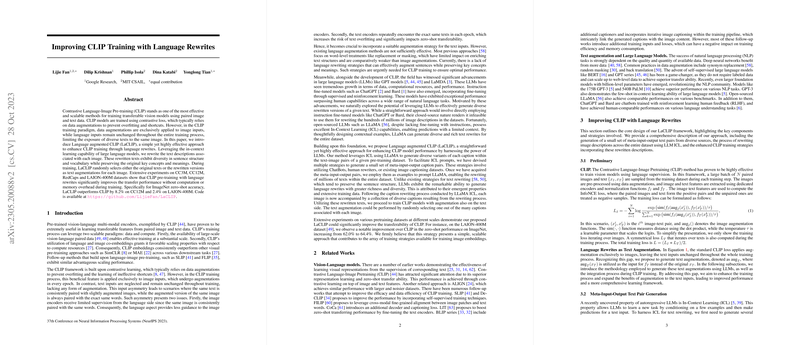Improving CLIP Training with Language Rewrites
The paper "Improving CLIP Training with Language Rewrites" presents Language augmented CLIP ({\name}), an innovative methodology for augmenting CLIP (Contrastive Language-Image Pre-training) using language rewriting techniques. This work aims to address the limitations of the existing CLIP training paradigm, which traditionally applies data augmentations only to image inputs, thereby neglecting opportunities for improvement on the language side. By leveraging LLMs for language augmentation, this paper significantly demonstrates enhanced model transferability in vision-language tasks.
Methodology
The authors highlight a critical gap in CLIP's standard training paradigm: while image data is subjected to augmentations, text data remains unchanged, which potentially constrains the model's performance. To mitigate this and improve zero-shot transferability, the paper introduces a novel augmentation strategy that applies language rewrites. Utilizing the in-context learning (ICL) capability of LLMs such as LLaMA, this approach generates semantically equivalent but syntactically diverse rewritten versions of the text descriptions associated with images.
The rewritten texts introduce diversity in sentence structures and vocabulary while maintaining the core semantic content. In each training iteration, either the original or a rewritten text is randomly paired with an image, thus enriching the dataset and improving the breadth of language supervision experienced by the model. This approach, importantly, doesn't add computational overhead during the training phase, maintaining efficiency while enhancing model performance.
Key Results
The empirical evidence provided in the paper underscores the effectiveness of {\name}. Specifically:
- On the CC12M dataset, {\name} improves ImageNet zero-shot accuracy by 8.2%, and the LAION-400M dataset shows a 2.4% increase.
- Across various architectures ranging from ViT-S/16 to ViT-L/16, {\name} consistently outperforms the baseline CLIP across zero-shot, few-shot, and linear-probing evaluation frameworks.
The experimentation with meta-input-output pairs from multiple sources like ChatGPT, Bard, MSCOCO, and human annotations further evidences the robustness of the language rewriting approach. The model demonstrates adaptability to scale, effectively handling large datasets such as LAION-400M.
Implications and Future Directions
The introduction of language rewrites as part of the CLIP training process has significant implications. By equating text augmentations with traditional image augmentations, this method broadens the scope of contrastive learning applications in multi-modal contexts. It offers a promising avenue for exploring compositionality and robustness in vision-LLMs, contributing to more generalized and transferable embeddings.
Moreover, this work paves the way for future innovations in vision-language pre-training frameworks, suggesting potential adaptations in other models, such as SLIP and Virtex. The results indicate that rewriting strategies could generalize beyond CLIP, potentially benefiting a wide array of vision-language tasks by fostering richer semantic understanding and alignment.
In conclusion, the paper provides a compelling case for integrating language rewrites into CLIP training, significantly advancing the field of vision-language pre-training. As LLMs continue to evolve, leveraging their capabilities for more sophisticated language augmentations could further enhance model performance, driving forward research at the intersection of natural language processing and computer vision.
